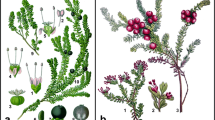Summary
Juniperus virginiana, a tree of eastern North America, is of comparatively minor yet significant economic importance. Most uses of its wood depend on its pleasant odor, distinctive appearance, or resistance to microbial decay.
Similar content being viewed by others
Literature Cited
Anderson, Edgar. Introgressive Hybridization. Wiley and Company, New York.
Barrett, John W. 1962. Regional Silviculture of the United States. Ronald Press Co. New York.
Fassett, N. C. 1943. The validity of Juniperus virginiana var. crebra. Amer. Jour. Bot. 469-477.
Harlow, Wm. M. & E. S. Harrar. 1968. Textbook of Dendrology. McGraw-Hill Book Co. New York.
Harrar, E. S. 1957. Hough’s Encyclopedia of American Woods. Robert Speller and Sons. New York.
Quarterman, Elsie. 1950. Major plant communities of Tennessee cedar glades. Ecology 31: 234–254.
Sternitzke, Herber S. 1955. Tennessee’s timber economy. U.S. Dept. Agr. Forest Resource Report. 9.27 pp.
Author information
Authors and Affiliations
Rights and permissions
About this article
Cite this article
Hemmerly, T.E. Economic uses of eastern red cedar. Econ Bot 24, 39–41 (1970). https://doi.org/10.1007/BF02860632
Received:
Issue Date:
DOI: https://doi.org/10.1007/BF02860632




